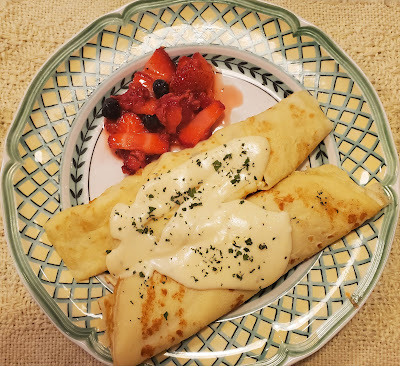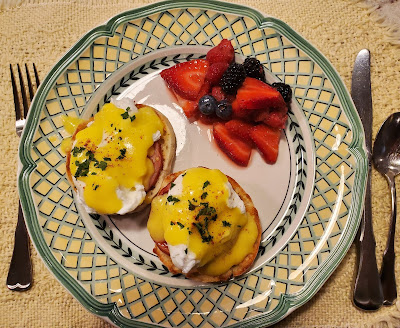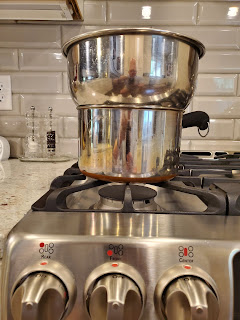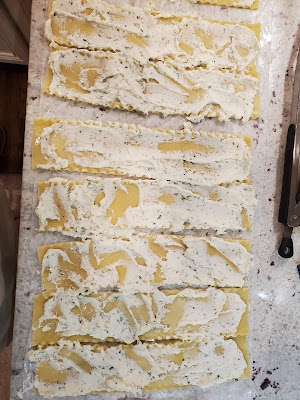I recently finished reading Dearie, a biography of Julia Child, by Bob Spitz. I had previously read My Life in France, an autobiography by Julia Child, but it really only dealt with the years that Julia and her husband Paul spent in France. Dearie covers Julia from cradle to grave and really details the struggles she went through to become a very famous cook and then to write and publish her cookbooks and become a TV icon. At any rate, it inspired me to do a little more French cooking, using some of the recipes in Mastering The Art of French Cooking, by Child, Bertholle and Beck as a starting point. To create the dish above I started by making the basic Crepe recipe from that famous cookbook. When I had the crepes done and held, I made a basic Bechamel(white sauce) and added cheese, which makes it a Mornay Sauce. While that sauce was holding on the stove top, I sauted 2 Tablespoons of diced onions and then added five eggs beaten with milk to the same saute pan and scrambled them. To assemble the dish you spoon a quarter of the scrambled eggs onto a crepe, roll it up and lay it on the serving plate with the seam side down. As you can see I did two crepes per serving, and then topped the crepes with the Mornay Sauce and garnished with a little chopped fresh parsley. Here are the recipes for each of the components:
For the Crepes: (From Mastering the Art of French Cooking, by Child, Bertholle and Beck)
Ingredients:
1 Cup Cold Water
1 Cup Cold Milk
4 Eggs
1/2 tsp Salt
11/2 Cups Flour
4 TBSP Melted Butter
Preparation:
Using a nonstick pan that is 6 - 8" at the bottom melt the butter on med. heat. While the butter is melting put the water, milk, eggs, and salt into a blender jar. Add the flour. Add the melted butter and blend on high speed for one minute. Scrape down the sides of the blender jar with a rubber scraper and then blend again for a few seconds. Cover and refrigerate for at least two hours.
The batter should be a very light cream, just thick enough to coat a wooden spoon. If after making your first crepe, it seems too heavy, beat in a bit of water a spoonful at a time. A cooked crepe should be about 1/16 inch thick.
To make the crepes, I use a little different method than explained in the referenced cookbook. Place the same nonstick pan that you used to melt the butter on a med-high flame. Add a couple more tablespoons of butter to the pan and let it melt. Pour the melted butter into a small dish. You will use this melted butter to brush your pan with between each crepe. Brush your pan lightly with the melted butter and place on the med high burner. When the pan just begins to smoke lift the nonstick skillet off of the heat in your left hand. Using a measuring cup ladle about 1/4 to 1/3 cup of batter onto the left top side of the pan and swirl the pan to create a thin layer of batter covering the bottom of the pan. The amount of batter will depend on the size of pan you are using. Return the pan to the heat and let cook for 60-80 seconds. Using a spatula of fork, lift the edge of the crepe to check for color. You want the bottom of the crepe to be a nice golden color. When you think the crepe is done on the bottom grasp the edge of the crepe closest to you and quickly flip it over toward the rear of the pan. Alternately you can flip the crepe using the pan, but this takes a little practice. Cook the second side of the crepe for about 30 seconds, or just until it begins to brown. This will be the inside of your crepe. Remove the crepe from the pan by flipping it brown side down onto a rack to cool. Then you can stack the crepes one on another to hold. They will also hold nicely in a warm oven.
For the Mornay Sauce:
Ingredients:
3 TBSP Butter
3 TBSP Flour
11/2 to 2 Cups Milk
1/2 Cup Grated Cheddar or Gruyere Cheese
Salt
White Pepper
Dried Thyme
Preparation:
In a small heavy bottomed saucepan, melt the butter over low heat. Add the flour and whisk into the melted butter, until you have a smooth bubbly paste. Cook for a couple minutes to eliminate the raw flour taste. The butter/flour mixture is called a roux and is used in many sauces as a thickener. Off the heat, begin adding milk about a half cup at a time while constantly whisking. Add 11/2 cups milk total and return to medium high heat. Continue whisking until sauce thickens. If sauce is too thick whisk in a little more milk. If too thin, continue cooking until sauce reduces and thickens. Once you have the sauce at the consistency you want, reduce heat to lo. Add Grated cheese and whisk in to melt the cheese and blend into the sauce. Flavor sauce to taste with salt, white pepper and dried thyme. Hold sauce on low heat.
For the Eggs:
Ingredients:
1 TBSP Butter
2 TBSP Finely Diced Onion
5 Large Eggs
2 TBSP Milk
Salt and Pepper to taste
Chopped Fresh Parsley
Preparation:
Melt butter over medium heat in a nonstick skillet. Add onion and Saute until translucent. While onion is cooking, crack eggs into a small bowl and add the milk. Whisk together until fully blended. Add eggs to the sauted onions and cook. When eggs start to solidify, begin stirring and turning with a spatula. When eggs are almost done, turn off heat. The eggs will continue to cook in the warm pan. Season to taste with the salt and pepper. Assemble the dish on plates as described above. Serve with fresh fruit or a mixed green salad and crusty bread.






